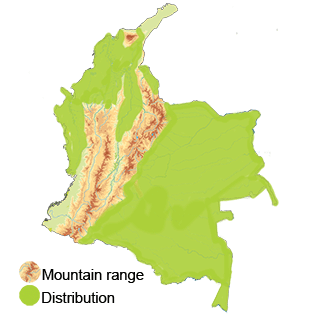Green Ibis
The Green Ibis (Mesembrinibis cayennensis)
Appearance: The Green Ibis is known for its unique and vibrant appearance. It has predominantly green plumage with a metallic sheen, contrasting with its red facial skin and legs. The bird has a long, slightly curved bill and a distinctive color pattern that sets it apart from other ibis species.
Habitat: Green Ibises inhabit wetland areas such as marshes, swamps, flooded forests, and riverbanks. In Colombia, they can be found in lowland regions, particularly in the Amazon rainforest and other tropical areas with abundant water sources.
Behavior: Green Ibises are typically solitary or found in small groups. They are often seen foraging in shallow water, using their long bills to probe for aquatic invertebrates, small fish, and other prey. These birds are known for their secretive and elusive nature, making them a challenge to spot in the wild.
Breeding: Green Ibises breed in colonies, often nesting in trees or dense vegetation near water. Breeding pairs engage in courtship displays that involve vocalizations, ritualized behaviors, and nest-building activities. The female typically lays a clutch of eggs, and both parents participate in incubation and caring for the young.
Distribution
The Green Ibis (Mesembrinibis cayennensis)
Amazon Rainforest: The Green Ibis is known to inhabit the Colombian Amazon region, where it can be found in wetlands, flooded forests, and along the riverbanks of the Amazon River and its tributaries.
Orinoco River Basin: This region, which includes parts of eastern Colombia, provides suitable habitat for the Green Ibis, with wetlands, marshes, and swamps supporting populations of this bird species.
Pacific Coast: Along the Pacific coast of Colombia, the Green Ibis may also be present in wetland areas, mangroves, and estuaries where it can forage for food and nest.
Magdalena River Valley: The ibis can be spotted along the Magdalena River and its surrounding wetlands, where it may find suitable breeding and foraging grounds.
Northern Andes: While less common in mountainous regions, the Green Ibis can still be found in the foothills and lower elevations of the Northern Andes in Colombia, particularly in wetland habitats.
Taxonomy
The Green Ibis (Mesembrinibis cayennensis)
- Kingdom: Animalia
- Phylum: Chordata
- Class: Aves (Birds)
- Order: Caprimulgiformes
- Family: Threskiornithidae
- Genus: Mesembrinibis
- Species: Mesembrinibis cayennensis
Vocalization
The Green Ibis (Mesembrinibis cayennensis)
The vocalizations of the Green Ibis are generally described as low-pitched, guttural calls or croaks. These calls may serve to communicate with other ibises in their group, establish territorial boundaries, or warn of potential threats in their environment. The sounds produced by Green Ibises are typically not as loud or elaborate as those of some other bird species.
It's worth noting that the vocal repertoire of the Green Ibis may vary depending on the specific context or behavior being exhibited.





